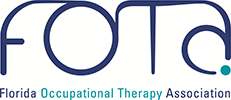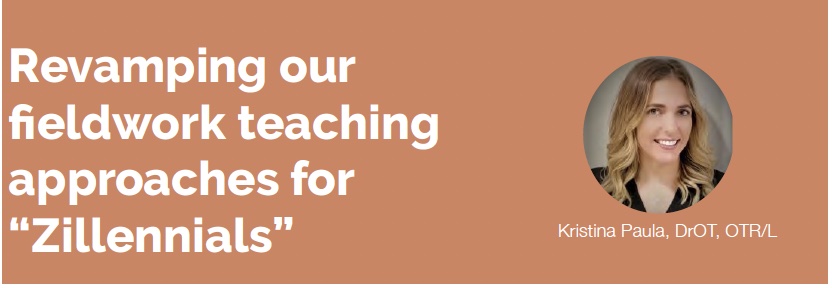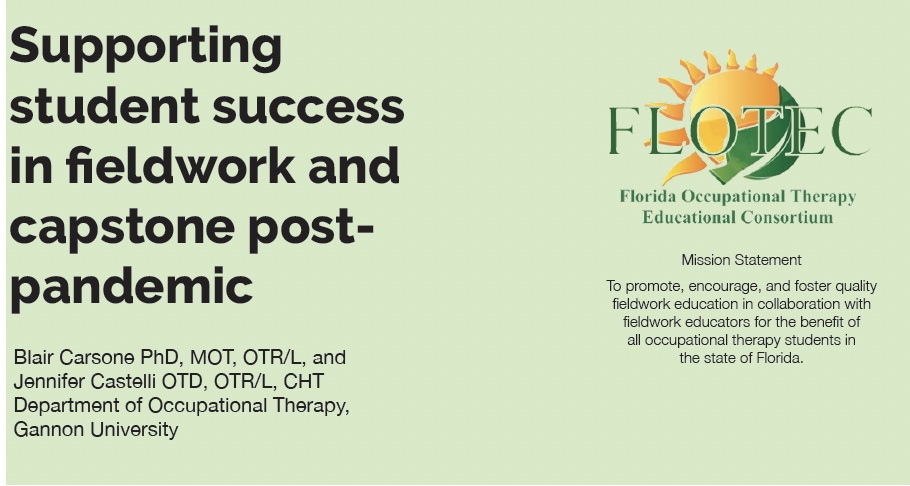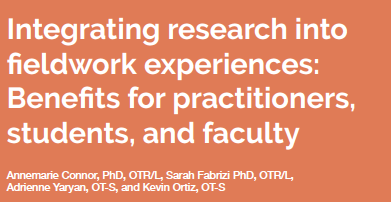 The Expanding Role of Occupational Therapy: Insights from the Doctoral Entry Level
The Expanding Role of Occupational Therapy: Insights from the Doctoral Entry LevelBy Pamela Kasyan-Howe, OTD, OTR/L
The entry-level Doctor of Occupational Therapy (OTD) degree marks a transformative advancement in OT education. It enables students to go beyond the basics of becoming an entry-level generalist, focused on reimbursable aspects of the profession, and develop into practitioners with advanced knowledge and skills in a specialized area of their own choosing.
This advanced degree has the potential to enhance the knowledge and skills of occupational therapists to handle the complexities of today's fast paced and changing healthcare system. Current healthcare trends include value-based care, using technology like telehealth, and focusing on personalized medicine. Shifting towards paying healthcare providers based on the quality of patient outcomes, rather than the volume of services, fits well with occupational therapy.
Value based care is particularly effective for managing individuals with chronic illnesses, which are often more challenging, however, these are the same populations that OT is effective. However, our traditional approaches focus on intervention at the individual level, and it's important to think about treating chronic illness at a broader levels—such as described in the occupational therapy practice framework (4th ed.) we can treat groups or entire communities, not just individuals (AOTA, 2020). Exploring our roles at the population level, this is where students in the OTD program can really add value to the field.
Broadening Professional Scope and Enhancing Critical Thinking
Traditionally, occupational therapy has centered on helping individual patients with everyday activities, a focus largely dictated by insurance coverage. This narrow scope often limits therapists' ability to fully address the diverse challenges that individuals may face in their daily lives. The OTD entry point seeks to change this by encouraging students to pursue their unique interests within the field working with groups, populations and communities. This approach not only diversifies the areas of practice beyond those typically covered by insurance but also sets the stage for therapists to open private practices that cater to a broader range of needs.
In the long run, this shift offers OT practitioners the opportunity to provide services that more comprehensively improve public health and wellness, addressing needs that are currently underserved by the existing healthcare models.
Encouraging Innovation Through Capstone Projects
A key component of the OTD curriculum is the capstone, which includes both a hands-on experience (capstone experience) and an individual project (capstone project). This element of the program is designed to spark creativity and innovation, allowing students to explore specific areas of interest under the guidance of experienced professionals and experts.
These projects are tailored to the students' career aspirations and interests, fostering a highly engaging and personalized educational experience. The outcome has the potential to create a generation of occupational therapists who bring new ideas and approaches to solving health and wellness challenges, enhancing the field's overall creativity and problem-solving capacity inside and outside traditional reimbursement models.
Developing Leadership and Expanding Professional Development
Leadership development is another critical aspect of the OTD program. Students are encouraged to delve into roles that involve advocacy, policy development, and community leadership. These experiences equip them with the skills necessary to effect positive changes in healthcare practices and policies.
The OTD also prepares therapists for roles beyond clinical practice, including in education, administration, and research. These roles are crucial for advancing the profession and ensuring occupational therapy has a prominent voice in the health sector.
Supporting Research and Building Evidence
The OTD entry point aligns with the AOTA’s research agenda to encourage studies that fill the existing knowledge gaps about the effectiveness of OT services for a broad scope of populations. This alignment encourages exploration and research to address the current gaps in knowledge about the effectiveness of OT services across a broad range of populations. Such focused efforts are crucial for enhancing the educational framework and deepening our understanding of the impact of the doctoral capstone to provide OT services.
Although OT capstone projects do not have to be focused soley on research, the requirement to disseminate the outcomes of the OTD student project will contribute to the publication of services OT’s can provide in relation to student projects such as program development, education, leadership, or management. Over time, dissemination of student capstone projects will build a repository that can be captured in a larger scale to provide evidence of position outcome from ot interventions.
Conclusion
The OTD degree is reshaping the field of occupational therapy by expanding its scope is reality versus in theory, fostering innovation, and reinforcing the importance of leadership and advocacy. This advanced approach ensures that occupational therapists are better equipped to address the evolving needs of the population, ultimately leading to a more effective and responsive healthcare system. As research continues to highlight the value of the OTD pathway, it is clear that this level of training is crucial for the ongoing growth and success of the profession in improving quality of life for individuals and communities alike.
References
American Occupational Therapy Association. (2020). Occupational therapy practice framework: Domain and process (4th ed.). American Journal of Occupational Therapy, 74(Suppl. 2), 7412410010.
https://doi.org/10.5014/ajot.2020.74S2001American Occupational Therapy Association. (2018). Occupational therapy Education Research Agenda—Revised. American Journal of Occupational Therapy, 72(Suppl. 2), 7212420070. https://doi.org/10.5014/ajot.2018.72S218
 Bridging the Gap: Promoting Clinical Fieldwork Educator Competency in Occupational Therapy Practice
Bridging the Gap: Promoting Clinical Fieldwork Educator Competency in Occupational Therapy Practice

 Transition from the IFSP to the IEP: The Changing Roles of the Occupational Therapy Practitioner in Part C vs Part B of IDEA
Transition from the IFSP to the IEP: The Changing Roles of the Occupational Therapy Practitioner in Part C vs Part B of IDEA Occupational Therapy Gives a Smile for Life
Occupational Therapy Gives a Smile for Life


 Integrating research into fieldwork experiences: Benefits for practitioners, students, and faculty
Integrating research into fieldwork experiences: Benefits for practitioners, students, and faculty